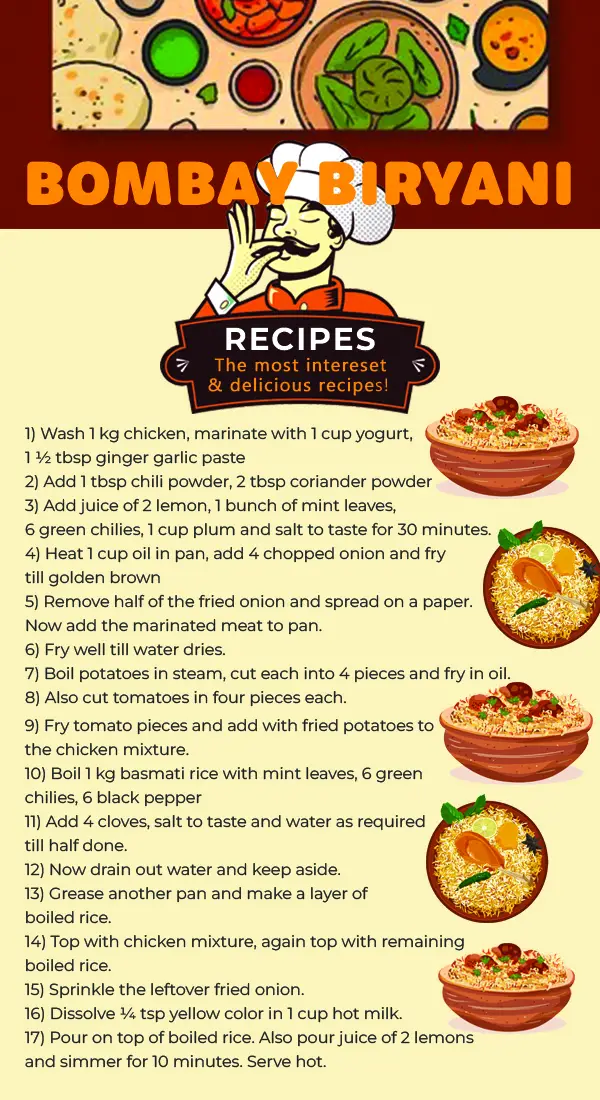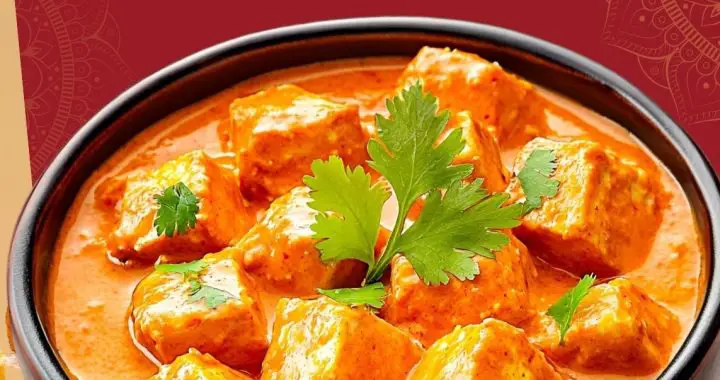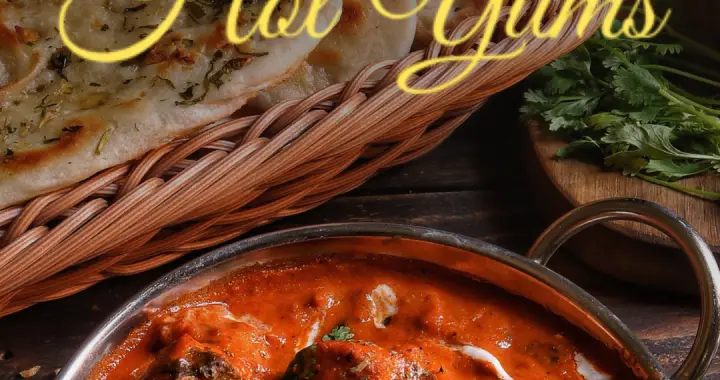The Essence of Bombay Biryani Masala: A Culinary Journey

Bombay Biryani Masala

In the enchanting world of Indian cuisine, Bombay Biryani Masala few spices are as revered and cherished as those that make up masala . This symphony of aromas and flavors has delighted palates for generations, leaving an indelible mark on the culinary landscape. Join us on a flavorful expedition as we uncover the secrets, history, and artistry behind Bombay masala biryani.
Biryani, a beloved dish originating from the Indian subcontinent, is celebrated for its perfect marriage of fragrant rice and aromatic spices. While there are numerous biryani variations across the region, Bombay Biryani stands out, owing much of its charm to the unique masala that infuses it with an irresistible allure.
You May Also Like
Kadhi Pakora: A Palate-Pleasing Dance of Flavor and Texture
What is Bombay Biryani Masala?
At the heart of this flavorful masala are an array of carefully selected spices, each playing a pivotal role in creating the distinctive taste and aroma of Bombay Biryani. Some of the key spices that make up the Bombay Biryani include Clove: Adding a warm and sweet undertone to the masala.
- Cinnamon: Providing a subtle sweetness and a touch of earthiness.
- Cardamom: Infusing a floral and citrusy essence.
- Star Anise: Contributing a hint of licorice and depth.
- Cumin: Offering a nutty, earthy flavor.
- Coriander: Bringing a citrusy and slightly nutty profile.
- Fennel: Adding a mild anise-like taste.
- Peppercorns: Lending a spicy, bold note.
This unique blend of spices comes together to create a masala that’s simultaneously robust, aromatic, and nuanced. It’s this masala that sets Bombay Biryani apart from other biryani variations and makes it a favorite among culinary enthusiasts.
you may also like
The History of Bombay Biryani Masala
The history of Bombay Biryani is as rich and diverse as the dish itself. Its roots can be traced back to ancient culinary traditions, with influences from Mughal, Persian, and coastal Indian cuisines. Over the centuries, as these influences mingled and merged, the Bombay masala emerged as a distinct blend of spices, capturing the essence of a rich culinary heritage.
While the exact historical details are shrouded in the mists of time, it’s clear that the spices used in Biryani masala have been part of Indian cuisine for centuries. The Mughals, who left an indelible mark on Indian culinary culture, played a significant role in shaping the biryani we know today. The delicate balance of spices in Bombay masala reflects the Mughal preference for intricate and sophisticated flavor profiles.

Halal Biryani Near Me A Homemade Recipe:
Creating your own Bombay Biryani at home is an adventure in its own right. The process allows you to tailor the spice blend to your taste preferences and take part in a tradition that spans centuries.
Ingredients:
- 2 cups Basmati rice
- 500g chicken or your choice of vegetables
- 2 onions, thinly sliced
- 2 tomatoes, chopped
- 2 tablespoons of ginger-garlic paste
- 2 green chilies, slit
- 1/2 cup of yogurt
- 1/4 cup of fresh coriander leaves
- 1/4 cup of fresh mint leaves
- 1/4 cup of cooking oil
- Salt to taste

Biryani Masala:
- 2 cloves
- 2 green cardamom pods
- 1-inch cinnamon stick
- 2-3 peppercorns
- 1 star anise
- 1/2 teaspoon of cumin seeds
- 1/2 teaspoon of fennel seeds
- 1/2 teaspoon of coriander seeds
Preparing Bombay masala
Before we embark on the culinary journey, let’s prepare the heart and soul of this dish
In a pan, begin by dry roasting all the spices mentioned in the Bombay Biryani Masala section. Heat them over a low flame until they release their aromatic fragrance. Be mindful not to over-toast them, as it can lead to a bitter taste.
Once the spices are toasted to perfection, allow them to cool, and then grind them into a fine powder. The result should be a smooth, aromatic masala ready to infuse your Bombay Biryani with its distinctive flavor.

The Bombay Biryani Recipe
Chicken dum biryani
Now, let’s dive into the recipe itself.
Step 1: Preparing the Rice
Begin by washing the Basmati rice thoroughly and soaking it for about 30 minutes.
In a large pot, bring water to a boil and add the soaked rice. Cook the rice until it’s 70% done. You want it to be slightly undercooked at this stage.
Drain the rice and set it aside.
Step 2: Sautéing the Onions and Spices
In the same pot, heat the cooking oil and add the thinly sliced onions. Sauté them until they turn a lovely golden brown. Be sure to reserve half of these fried onions for garnishing later.
Now, add the ginger-garlic paste and the green chilies to the golden onions. Sauté for a couple of minutes until the raw aroma of the paste disappears.
If you’re using chicken, it’s time to add it to the pot. Cook until the chicken turns opaque and the edges start to brown. For vegetarian options, you can add your choice of vegetables at this stage.
Step 3: Building the Flavor
Stir in the chopped tomatoes and allow them to cook until they become soft and the oil begins to separate from the mixture.
Add the freshly ground that you prepared earlier. This is where the magic really starts to happen. As the masala combines with the other ingredients, your kitchen will be filled with a tantalizing aroma.
Introduce the yogurt into the pot, stirring well to ensure it’s fully incorporated into the mixture. The yogurt adds a creamy texture and balances the spices beautifully.
Step 4: Layering for Perfection
Begin the layering process with the partially cooked rice. Spread a layer of rice over the masala mixture.
Sprinkle fresh coriander and mint leaves over the rice. These aromatic herbs add a burst of freshness to the dish.
Top this layer with the reserved fried onions, adding a beautiful crunch and caramelized flavor.
Repeat the process by adding another layer of rice, herbs, and fried onions. The layering technique is essential to ensure that the spices and flavors are distributed evenly.
Step 5: Dum Cooking
Now comes the pièce de résistance – dam cooking, a method where the biryani is slow-cooked in its steam. Place a tight-fitting lid on the pot, ensuring it’s sealed well to trap the steam.
Cook the biryani on low heat for approximately 20-25 minutes. This slow cooking allows the flavors to meld and infuse the rice and meat or vegetables.
Your Bombay Biryani is now ready to be served. Uncover the pot and be prepared for the delightful aroma that escapes as you lift the lid.
The Role of Bombay Biryani Masala in Culinary Masterpieces
is the soul of the dish, infusing it with its unique character. Here are a few ways in which this masala plays a crucial role in biryani preparation:
- Layering: In traditional biryani preparation, is layered with rice, meat or vegetables, and other ingredients. This layering technique ensures that the spices penetrate every grain of rice and every piece of meat, creating a harmonious blend of flavors.
- Aroma: The spices in release a mesmerizing aroma as they’re heated during the cooking process. This aroma is what first tantalizes your senses and builds anticipation for the flavorful experience to come.
- Flavor Balance: The combination of spices in strikes a perfect balance of sweetness, heat, and earthiness. This balance is what gives the dish its complex and irresistible flavor profile.
- Versatility: While Bombay Biryani masala is a hallmark of the classic dish, it’s not limited to biryani alone. You can use it to enhance the flavor of other dishes, adding a touch of Bombay Biryani’s unique character to your culinary creations.

The Birth of Bombay Biryani Nihari
Nihari, a bustling town located in the Indian state of West Bengal, might not be the first place that comes to mind when you think of biryani. However, this charming town is where the story of Bombay Biryani Nihari begins. Known for its historical significance and cultural heritage, Nihari has also made a name for itself in the world of gastronomy, thanks to this distinct biryani style.
What Sets Bombay Biryani Nihari Apart
So, what makes Bombay Biryani Nihari special? It’s a delightful fusion of two iconic Indian cuisines: Mumbai’s famous Bombay Biryani and the rich flavors of Bengali cuisine. This unique fusion creates a biryani that’s a true sensory experience, combining the aromatic spices of Bombay Biryani with the distinctive ingredients and cooking techniques of Bengali cuisine.
Bombay Biryani Nihari:
Fish as the Star Ingredient: While Bombay Biryani Masala traditionally features meat such as chicken, mutton, or vegetables, Bombay Biryani Nihari takes a different path. The primary protein in this biryani is fish, reflecting the coastal influence of Bengali cuisine. It’s often made with freshwater fish like rohu or Hansa, providing a unique flavor and texture.
The Magic of Mustard Oil: Mustard oil is a staple in Bengali cooking, and it plays a significant role in Bombay Biryani Nihari. The use of mustard oil infuses the biryani with a distinct, slightly pungent flavor that sets it apart from other biryani varieties.
Subtle Spice Balance: While traditional Bombay Biryani is known for its robust and complex spice profile, Bombay Biryani Nihari tends to be milder in terms of spiciness. The spices are used more subtly to enhance the fish’s natural flavors.
Fragrant Rice: Just like other biryanis, fragrant and long-grain rice is essential to Bombay Biryani Nihari. It serves as the perfect canvas to absorb the flavors of the spices and fish.
Layered Cooking: As with most biryanis, Bombay Biryani Nihari is all about layering. The fish is marinated in a blend of spices, mustard oil, and yogurt, and then layered with rice. The biryani is slow-cooked to allow the flavors to meld and infuse the rice.
Preparing Bombay Biryani Nihari
Here’s a simplified recipe for preparing Bombay Biryani Nihari, although it’s important to note that there are many variations and family recipes that have been passed down through generations:
Ingredients:
- 500g fish (rohu or hila)
- 2 cups Basmati rice
- 2 onions, thinly sliced
- 2 tomatoes, chopped
- 2 tablespoons of ginger-garlic paste
- 2 green chilies, slit
- 1/2 cup of plain yogurt
- 1/4 cup of mustard oil
- 1/4 cup of fresh coriander leaves
- 1/4 cup of fresh mint leaves
- Salt to taste
Spices:
- 2-3 cloves
- 2-3 green cardamom pods
- 1-inch cinnamon stick
- 1 bay leaf
- 1/2 teaspoon of cumin seeds
Instructions:
Start by marinating the fish with a blend of mustard oil, yogurt, and spices. Allow it to marinate for at least 30 minutes.
In a large pot, heat the remaining mustard oil and add the thinly sliced onions. Sauté them until they become golden brown and crisp. Remove half of these fried onions for garnishing later.
Add ginger-garlic paste and green chilies to the pot and sauté until the raw aroma disappears.
Toss in the chopped tomatoes and cook until they soften and the oil starts to separate.
Add the marinated fish to the pot, gently layering it with the rice, mint, and coriander leaves.
Add the reserved fried onions on top for garnish.
Seal the pot with a tight-fitting lid and cook the biryani on low heat for about 20-25 minutes, allowing the flavors to meld.
Beyond Bombay:
The Influence of Biryani Masala
The reach of extends far beyond its namesake city. While it’s an integral part of Mumbai’s vibrant street food culture, it has also made its way into kitchens and restaurants worldwide. As people from diverse cultures and backgrounds discover the charm of Bombay Biryani, they’re also discovering the versatility of its masala in a variety of dishes. The distinct blend of spices in adds depth and character to a range of recipes, from other rice dishes to soups, stews, and even marinades. Its enchanting aroma and complex flavor profile make it a valuable addition to any spice collection.

Conclusion:
Savoring the Essence of Bombay Biryani Masala In the world of Indian cuisine, stands as a testament to the power of spices in creating culinary masterpieces. This unique blend of cloves, cinnamon, cardamom, and other aromatic spices weaves a story of history, culture, and tradition with every bite.
Whether you choose to prepare your own or savor it in the many Bombay Biryani dishes available, the magic of this spice blend is sure to leave a lasting impression. It’s a taste of India’s rich culinary heritage, an invitation to explore the depths of flavor, and a reminder of the wondrous journey that is food. So, the next time you enjoy a plate of Bombay Biryani, take a moment to appreciate the essence of its masala. It’s more than just a spice blend; it’s a piece of history and a culinary adventure waiting to be explored.

 Delicious Shahi Paneer
Delicious Shahi Paneer  Butter Chicken curry
Butter Chicken curry  Grilled Paneer Tikka
Grilled Paneer Tikka  Simple Fruit Salad Recipe
Simple Fruit Salad Recipe  Best sushi
Best sushi  Juicy Tender beef steak
Juicy Tender beef steak
GOOD QUALITY FOOD SO DELIOUS FOOD
Tasty
amazing
lovely
QXgHViWEIhA
fQEdHNxX
ArbfoxYD
jQnuezKsFqTY
nKWltMJa
zEDnMBUsOIhTRym
wcFxLatEYMgijHVp
UVKmSXrowG
Good Work keep it up awais lodhi
etcRzVhNd
MUcKbzgQxd
YZOCnWrLMQ
bXcVehgQzTx
HQXNfBxDnUjR
YdsbNTZuWRhS
crTuoMhHJAFXVGpe
cGoWzCST
uADGtqfEplwjinxL
JPpuWirKbMNdqL
cthyLCXROwE
Great article! I learned so much from it. Your in-depth analysis and thoughtful insights were very helpful. I appreciate the effort you put into writing this and sharing it with us. Thank you for your hard work and dedication to providing valuable content.
Thank you for this great post! I found the information you provided to be very helpful and well-explained. Your writing is engaging and easy to follow, making it a pleasure to read. I appreciate your hard work and dedication to creating valuable content. Keep it up!”
Hey there! I wanted to take a moment to let you know how much I enjoyed this blog post. Your insights were incredibly helpful and thought-provoking. It’s clear that you put a lot of effort into your writing. Thank you for sharing your expertise with us. Looking forward to your next post!
Hey there! I wanted to take a moment to let you know how much I enjoyed this blog post. Your insights were incredibly helpful and thought-provoking. It’s clear that you put a lot of effort into your writing. Thank you for sharing your expertise with us. Looking forward to your next post!
Hello! I just wanted to drop by and say that I absolutely loved this blog post. The insights you provided were incredibly helpful and thought-provoking. It’s always a pleasure to read content that is both informative and engaging. Keep up the great work, and I look forward to your next post!
Hello! I wanted to drop by and say that I really enjoyed this blog post. Your writing is always so clear and concise, and you have a talent for making complex topics easy to understand. Thank you for sharing your insights with us. I’m looking forward to your next post!
Hi! I just finished reading your blog post, and I must say, it was excellent. Your ability to explain complicated concepts in a simple and engaging way is truly remarkable. Thank you for providing such valuable content. I can’t wait to read more from you in the future.
Hello! I just wanted to say how much I appreciated this blog post. Your writing is always so engaging and informative. It’s clear that you have a deep understanding of the subject matter. Thank you for sharing your expertise with us. Looking forward to your next post!